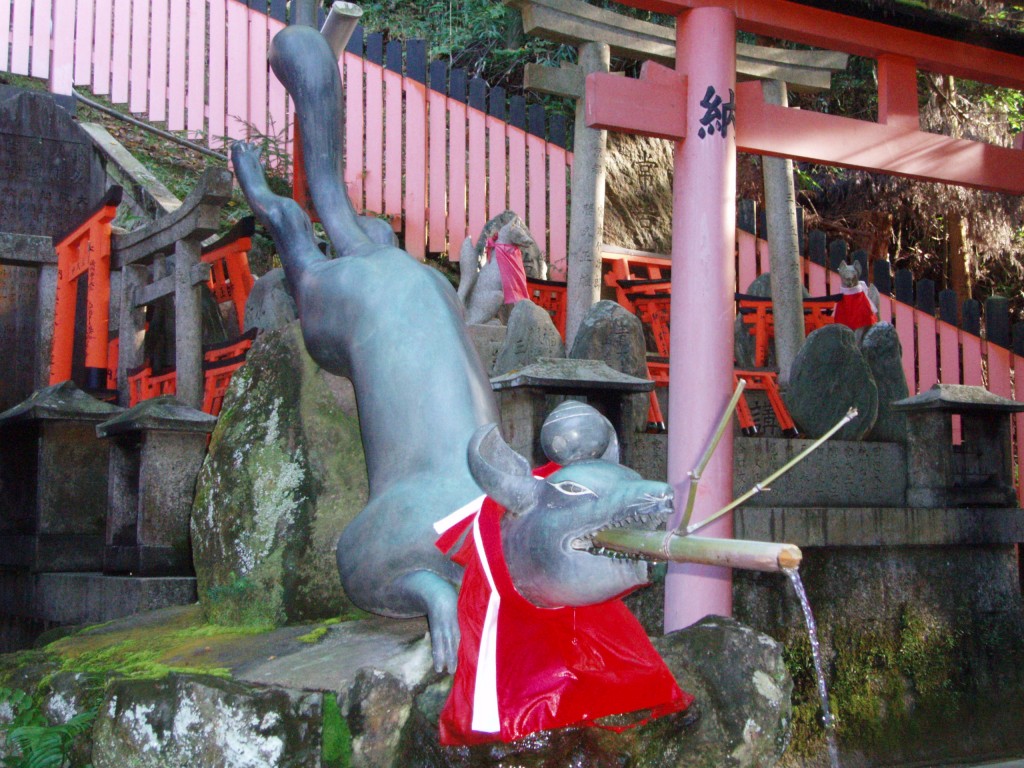
‘The Fox and the Jewel’ by Karen A. Smyers US: Univ. of Hawaii, 1999 271 pages, medium size. ISBN 0-8248-2102-5
The book is subtitled ‘shared and private meanings in contemporary Japanese Inari worship’, though in a sense the book is more a study of two Inari centres: Fushimi Inari in Kyoto, and Toyokawa Inari in Aichi prefecture. The former is a well-known Shinto shrine, the latter a Soto Zen temple. The author is an anthropologist who has written on various aspects of Japanese religion, and here she explores in detailed but accessible manner various aspects of Inari. Together with Hachiman and Tenjin, the deity is among the most popular of kami and closely associated with rice and business success. Sometimes pictured as a young woman and sometimes as an old man, Inari is accompanied by foxes who act as the deity’s messengers. Worship bridges Shinto and Buddhist traditions in the form of Dakiniten, and Smyers unpacks aspects of the cult in systematic manner. She provides a history and examination of the origins, as well as investigative probes into the priestly structures at the shrine and temple. She also spends much time investigating why the places are so popular for pilgrimage and what kind of activities are carried out. There are several case studies drawn from lay worship groups, and distinction is drawn between the male priestly rituals and informal female shamans who draw on direct experience. Though they coexist, there is also friction between them.
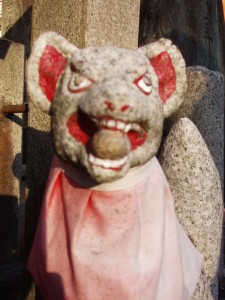
Two of the chapters deal with the titular attributes, the fox and the jewel. The fox is rich in folklore, and the author speculates about the liminal nature of the creature, moving in and out of the darkness as if between worlds. Different people see different facets in the fox, and from China came a strong association with sorcery. Traditionally fox possession was seen as resulting in severe illness. The statues of foxes that stand before Inari shrines invariably have a wishing-jewel, which can facilitate the fruition of potential and may also be related to the creature’s shape-shifting. There is much too in these chapters of the phallic and sexual implications, with the yin-yang interaction energising the fertility fostered by the deity.
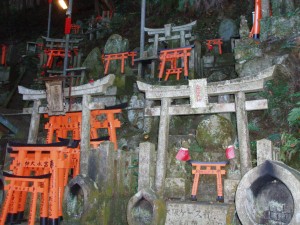
Otsuka covered with torii
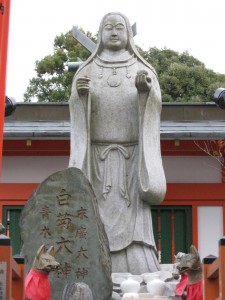
Artist's impression of one of Inari's manifestations
One of the most interesting sections for those like myself familiar with Fushimi Inari was that about the ‘otsuka’ or rock altars. These were a spontaneous development at the end of the Edo period which was originally opposed by priests. There are now some 10,000 of these rock altars, which are inscribed with individualised names of deities covering a wide range. And this plurality and flexibility is what emerges most clearly at the end of the book, for Inari worship more than most consists of personal response and individual imagination. As the author herself concludes, ‘The deity Inari has a number of forms, variable gender, and a variety of specialities that have changed as Japanese society has developed… Because there is no central myth, dogma, or scripture that accompanies the symbols, there is no fixed orthodoxy governing them. Their significance is not tied to a set of verbal meanings’.
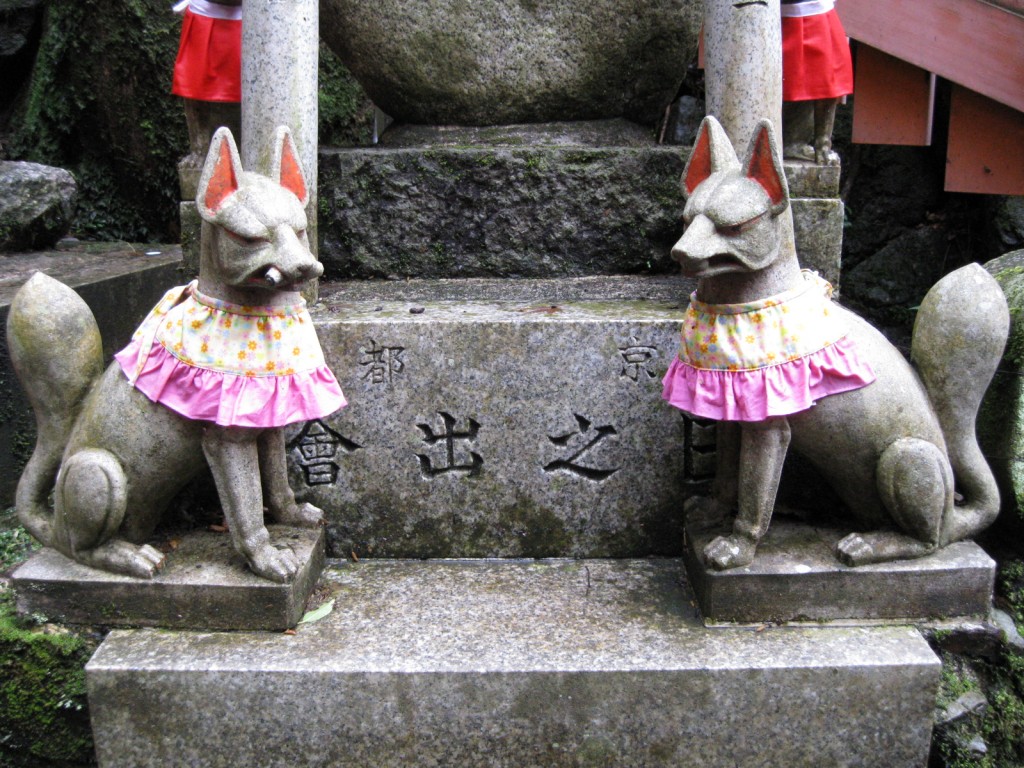

I found “The Fox and the Jewel” to be clearly written, especially for an academic work. It avoids much of the overly complex language that some academics seem to feel is required, and it is well organized and easy to follow from section to section. There’s a clear thesis and discussion of that thesis in each section, and a reasonable conclusion to go along with it. It had extensive documentation and footnotes. It was also nice to read something recent, instead of some of the older references people suggest.
I found this book really interesting. I don’t have any firsthand experience with Shinto in Japan, so this helped make it clear that Shinto is not a monoculture. It made clear that there is a wide variety of beliefs inside the same shrine, much less across all of Shinto. This isn’t something that all the English resources explain, and I think it’s a profound thing to understand how personal and varied the practice of Shinto can be.
There was lots of information about how Inari is regarded by the priests and by the people. I was impressed by how different those were, and how little they seemed to try and reconcile those differences. That seemed to me, with my American upbringing, a refreshing change from so many of the Christians you hear from. (I’ll be fair and point out that there’s a ton more Christians who don’t drive for any kind of unification but you don’t hear from them.)
I also found it interesting how active shamanism appears to be in many of the ko groups, and how many people had personal interactions with the kami, and how many felt that was critical and important. In contrast, the priests didn’t seem to push that, and mostly left them alone.
There was a lot of discussion of etymology in the book, which I know is important, but was not as interesting to me as the reactions of the people today. That’s my bias; I know it’s an important way to understand a lot of aspects of Japanese history, but I usually prefer to read about what people now do, than how it got to where it is today.
I found it amusing how many different kami are regarded as Inari, and was tickled by the incredible variety of things people associate with Inari. I liked that people personalize Inari to their needs so they can have this familiar and trusted force working for their specific issues. Many of these are represented in the rock altars, which I also found interesting.
I liked the book, and found it valuable, especially if you want the details of Inari, or a deeper look into the ways people worship a specific kami.